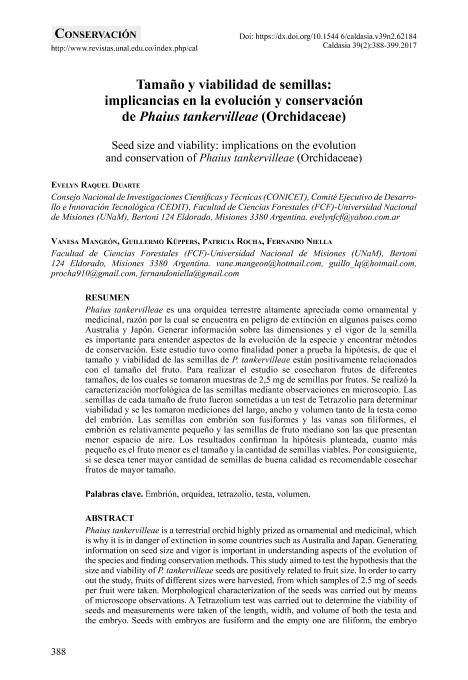Artículo
Phaius tankervilleae es una orquídea terrestre altamente apreciada como ornamental y medicinal, razón por la cual se encuentra en peligro de extinción en algunos países como Australia y Japón. Generar información sobre las dimensiones y el vigor de la semilla es importante para entender aspectos de la evolución de la especie y encontrar métodos de conservación. Este estudio tuvo como fnalidad poner a prueba la hipótesis, de que el tamaño y viabilidad de las semillas de P. tankervilleae están positivamente relacionados con el tamaño del fruto. Para realizar el estudio se cosecharon frutos de diferentes tamaños, de los cuales se tomaron muestras de 2,5 mg de semillas por frutos. Se realizó la caracterización morfológica de las semillas mediante observaciones en microscopio. Las semillas de cada tamaño de fruto fueron sometidas a un test de Tetrazolio para determinar viabilidad y se les tomaron mediciones del largo, ancho y volumen tanto de la testa como del embrión. Las semillas con embrión son fusiformes y las vanas son fliformes, el embrión es relativamente pequeño y las semillas de fruto mediano son las que presentan menor espacio de aire. Los resultados confrman la hipótesis planteada, cuanto más pequeño es el fruto menor es el tamaño y la cantidad de semillas viables. Por consiguiente, si se desea tener mayor cantidad de semillas de buena calidad es recomendable cosechar frutos de mayor tamaño. Phaius tankervilleae is a terrestrial orchid highly prized as ornamental and medicinal, which is why it is in danger of extinction in some countries such as Australia and Japan. Generating information on seed size and vigor is important in understanding aspects of the evolution of the species and finding conservation methods. This study aimed to test the hypothesis that the size and viability of P. tankervilleae seeds are positively related to fruit size. In order to carry out the study, fruits of different sizes were harvested, from which samples of 2.5 mg of seeds per fruit were taken. Morphological characterization of the seeds was carried out by means of microscope observations. A Tetrazolium test was carried out to determine the viability of seeds and measurements were taken of the length, width, and volume of both the testa and the embryo. Seeds with embryos are fusiform and the empty one are filiform, the embryo is relatively small and the seeds of medium size fruit are those that have less air space. The results confirm the hypothesis, the smaller the fruit the smaller the size and the number of viable seeds. Therefore, to have more seeds of good quality it is advisable to harvest larger fruits.
Tamaño y viabilidad de semillas: implicancias en la evolución y conservación de Phaius tankervilleae (orchidaceae)
Título:
Seed size and viability: implications on the evolution and conservation of Phaius tankervilleae (orchidaceae)
Duarte, Evelyn Raquel ; Mangeón, Vanesa; Küppers, Guillermo Federico; Rocha, Sandra Patricia; Niella, Fernando Omar
; Mangeón, Vanesa; Küppers, Guillermo Federico; Rocha, Sandra Patricia; Niella, Fernando Omar
 ; Mangeón, Vanesa; Küppers, Guillermo Federico; Rocha, Sandra Patricia; Niella, Fernando Omar
; Mangeón, Vanesa; Küppers, Guillermo Federico; Rocha, Sandra Patricia; Niella, Fernando Omar
Fecha de publicación:
07/2017
Editorial:
Instituto de Ciencias Naturales
Revista:
Caldasia
ISSN:
0366-5232
e-ISSN:
2357-3759
Idioma:
Español
Tipo de recurso:
Artículo publicado
Clasificación temática:
Resumen
Palabras clave:
Embrión
,
Orquídea
,
Tetrazolio
,
Testa
,
Volumen
Archivos asociados
Licencia
Identificadores
Colecciones
Articulos(CCT - NORDESTE)
Articulos de CTRO.CIENTIFICO TECNOL.CONICET - NORDESTE
Articulos de CTRO.CIENTIFICO TECNOL.CONICET - NORDESTE
Citación
Duarte, Evelyn Raquel; Mangeón, Vanesa; Küppers, Guillermo Federico; Rocha, Sandra Patricia; Niella, Fernando Omar; Tamaño y viabilidad de semillas: implicancias en la evolución y conservación de Phaius tankervilleae (orchidaceae); Instituto de Ciencias Naturales; Caldasia; 39; 2; 7-2017; 388-399
Compartir
Altmétricas



